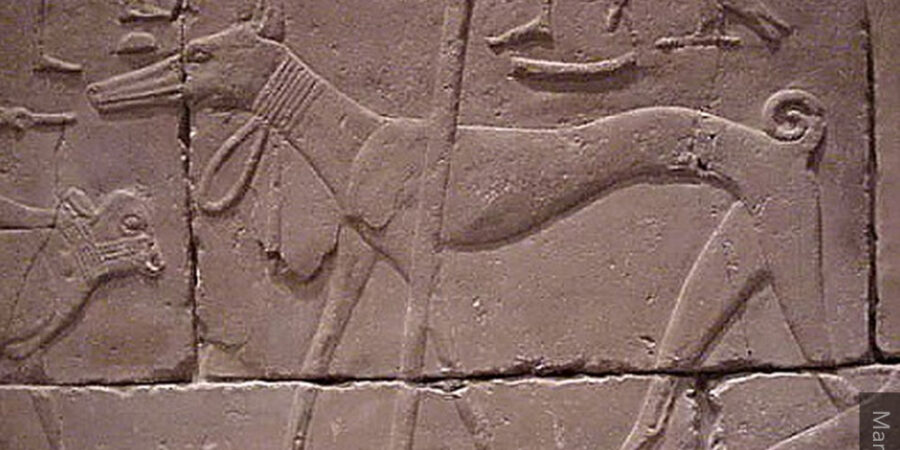The Greyhound, the most ancient breed of dog with a fascinating history spanning over 4,000 years, is notable for its representation within numerous ancient civilizations. It holds the distinct honor of being the only dog breed mentioned in the Bible.
Early Records and Evidence
Depictions in Ancient Artworks: Greyhounds have been prominently featured in various forms of historical art, such as murals and paintings dating back well over 4,000 years, indicative of the breed’s antiquity.
Archaeological Evidence: A canine mummy with features resembling a greyhound was discovered in a tomb dating back to 6000 BC, further emphasizing the greyhound’s ancient roots.
Cultures Celebrating Greyhounds
Despite the breed’s indeterminable origins, greyhounds have held a prestigious allure amongst several cultures over time.
Egyptians
The Egyptians held greyhounds in the highest esteem, elevating them to near-divine status.
Role in Egyptian Society: Greyhounds in ancient Egypt fulfilled multiple societal roles. They were prized as both pets and hunters. Egyptian nobility, including the kings and high-ranking hierarchy, often staged races where their greyhounds would chase wild game. Fast hounds were highly valued and were commonly believed to bring favor in the king’s eyes.
Greyhounds in Egyptian Art: Greyhounds feature heavily in Egyptian tomb decor. Given that only things of significance were chosen for representation in these sacred sites, the portrayal of greyhounds highlights their cultural importance during this era.
Greeks and Romans
Greyhounds also played a foundational role in Greek and Roman cultures, with their likeness often associated with Greek deities and Roman leisure activities.
Greek Portrayal: Many of the Greek gods are depicted alongside greyhounds, demonstrating the breed’s perceived power and status within the Greek pantheon.
Roman Coursing: Romans took great pleasure in coursing, a sport that involves the pursuit of game (or a substitute) by dogs—chiefly greyhounds. Interestingly, Romans ran their dogs purely for the thrill of the chase, rather than for food hunting.
Endearing Legacy
Even today, the greyhound continues to captivate audiences worldwide with its lightning speed, sleek physique, and ancient lineage, perpetuating its status as one of the most revered dog breeds in history.
Greyhound in Arabian Culture
Like the Egyptians, the Arabians highly valued the greyhound, which became a sought-after breed due to its esteemed position in society.
High Regard: Greyhounds were the only dogs permitted to ride camels and be allowed into tents, indicative of their revered status among the Arabians.
Middle Ages and the Greyhound’s Resurgence
During the Middle Ages, greyhounds experienced a near brush with extinction, brought on by famine, but they managed to make a remarkable comeback.
Clergymen’s Intervention: Clergymen played a crucial role in preserving the greyhound breed during times of scarcity.
Protection by Nobility: Greyhounds found favor with the nobility, who went to great lengths to care for and breed them. King Howel even declared in the 10th century that killing a greyhound would be punishable by death. Unlike most dogs during this time, which were deemed valueless and treated poorly, greyhounds were considered elegant and noble.
Hare Coursing and Queen Elizabeth I
Greyhound coursing gained prominence after Queen Elizabeth I established the first formal rules for hare coursing.
Coursing Club Formation: Following the Queen’s initiation, the first official coursing club was established in 1776 at Swaffham.
Nineteenth Century and Waterloo Cup
In the 19th century, greyhounds continued to be favored by nobility and royalty, and greyhound coursing saw a further surge in popularity.
Waterloo Cup: The Waterloo Cup, a prestigious greyhound coursing event, was founded in 1837.
Greyhound Importation to the United States: During this time, greyhounds were imported to the United States in an effort to control the growing jackrabbit population, which was damaging crop fields.
Birth of Greyhound Racing
Greyhound racing found its beginnings in the early 20th century, establishing itself as a staple of British sporting events.
First Greyhound Race Meeting: The inaugural greyhound race took place in July 1926 at Belle Vue in Manchester.
White City’s Debut: In June 1927, the famous White City stadium in London hosted its first greyhound race, quickly gaining widespread attention and drawing an estimated 100,000 people per meeting.
Greyhound racing solidified its place as a formidable sporting event, with its roots tracing back to ancient civilizations that admired and respected this unique dog breed.
Greyhound Racing Emergence in England
The inception of greyhound racing in England is attributed to American Charles Munn, who pioneered the implementation of the mechanical lure or hare in races and played a significant role in popularizing the sport.
First Track: The first official greyhound racing track opened at Belle Vue. The venture’s prosperous financial outlook motivated the planning of additional tracks at Harringay and White City.
National Greyhound Racing Club (NGRC)
Given the rising popularity of greyhound racing and the subsequent risk for malpractice, the establishment of a nationally controlled organization became a necessity.
Founding Meeting: The founding meeting for the NGRC took place at Wembley, where track promoters gathered to discuss plans for a nationally regulated club.
Structure: The NGRC’s design was inspired by the structure of the horse racing jockey club.
Inauguration Date and Membership: The NGRC formally came into existence on 23 April 1928, with as many as 43 tracks subscribing to its regulatory legislation at the time of its foundation.
Popularity Among Working Class
Greyhound racing, owing to its urban locations and evening race cards, became an immensely popular pastime among the working class.
Patron Variety: Both owners and patrons from diverse backgrounds found allure in greyhound racing, making it a broadly inclusive sport.
Role of Gambling: Gambling emerged as a significant aspect of greyhound racing, appealing to a substantial share of patrons, and continues to act as the backbone of the industry.
Decline and Persistent Popularity of Greyhound Racing
Though greyhound racing saw its heyday in the period following World War II, changes in betting practices and the rise of televised and internet sports have since brought about a decline.
Impact of Betting Legalisation: The legalisation of off-course betting, particularly in betting shops, disrupted the popularity of on-track betting at greyhound races.
Televised and Internet Sports: Televised sports coverage and the dawn of internet betting have made it easier for punters to participate in betting without leaving the comforts of their homes.
Despite these challenges, the popularity of greyhound racing perseveres, deeply rooted in various global communities.
Support Base: Greyhound racing still enjoys a strong grassroots following, with fans spanning across the socio-economic spectrum.
Ranking in England: The sport remains a popular spectator activity in England, with races conducted all over the country due to its widespread popularity.
Frequency of Races: To meet the significant demand from punters and bookmakers, greyhound races are held seven days a week, at various times throughout the day, including morning, noon, and night.
Global Reach of Greyhound Racing
Greyhound racing is not just confined to England; it continues to be popular worldwide, with several countries leading the industry.
Top Nations: Ireland, Australia, and America hold prominent positions in the greyhound industry, showcasing the sport’s wide international appeal.
Frequently Asked Questions on Greyhound History and Racing
Q: What is the origin of the greyhound breed?
A: Greyhounds are one of the oldest dog breeds with origins dating back thousands of years, possibly to ancient Egyptian civilization. Ancient burial sites have revealed depictions of greyhound-like dogs, hinting at the long-standing relationship between humans and this breed. The greyhounds we know today, however, were most likely developed in Europe during the Middle Ages, with the name “greyhound” derived from Old English terms that could mean either “fine dog” or “dog hunter.”
Q: How did greyhounds arrive in the U.S.?
A: Greyhounds were brought to the U.S. primarily for hunting and controlling the jackrabbit population which was damaging crop fields. Their importation happened mainly in the 19th century. These dogs excelled in the task due to their tremendous speed and reliable hunting instincts.
Q: What makes greyhounds the fastest breed of dog?
A: Greyhounds are the fastest breed of dog due to their unique physical characteristics. They have a light, aerodynamic build and an exceptionally flexible and elongated body for greater stride length. They also have larger hearts and lungs compared to other dogs of similar size, enhancing their oxygen processing capacity and allowing them to maintain high speeds over longer distances.
Q: Why is coursing significant in greyhound history?
A: Coursing, or the pursuit of game by dogs chasing it by sight rather than by scent, has been a significant aspect of greyhound history. Initially, it was done for hunting purposes, but it eventually evolved into a sport. Around the time of the reign of Queen Elizabeth I, the first formal rules of coursing were established. This sport eventually led to the modern form of greyhound racing we know today.
Q: When and where did official greyhound racing start?
A: The first official greyhound race took place at Belle Vue in Manchester, England, in July 1926. Charles Munn, an American, established the concept in the U.K. After the success of this initial race, greyhound racing rapidly gained popularity, and tracks began to spring up all over the country.
Q: How has gambling influenced greyhound racing?
A: From its inception, betting has been an integral part of greyhound racing – it’s often considered the backbone of the sport. Attendees of greyhound races would traditionally place bets on the outcomes, adding an additional layer of excitement to the events. However, with the advent of off-course betting, internet betting, and betting shops, the need to physically attend races declined, contributing to decreased race attendances.
Q: How popular is greyhound racing today?
A: While the popularity of greyhound racing has waned due to factors like off-course betting and televised sports, it remains a notable sport in many parts of the world. Countries like Ireland, Australia, and the United States also continue to maintain a significant interest in greyhound racing.
Q: What are the welfare concerns in greyhound racing?
A: Greyhound racing has faced criticism due to welfare concerns for the dogs involved. Some of these concerns include the living conditions of the dogs, potential overbreeding, lack of rehoming efforts for retired racing dogs, and injuries that can occur during races. In response to these concerns, many efforts have been taken to improve the welfare of racing greyhounds, including tighter regulations and greater focus on greyhound adoption.
Q: How are retired racing greyhounds cared for?
A: Today, many organizations and adoption groups are dedicated to rehoming retired racing greyhounds. These dogs are known for their gentle dispositions and ability to adapt well to home environments, making them popular pets. The greyhound racing industry has seen improvement in ensuring the welfare of their dogs after retirement, but further work is needed to ensure all retired greyhounds find loving homes.
Q: Can greyhounds make good pets?
A: Yes, greyhounds are often praised for their gentle and friendly nature. They can make excellent family pets and are known for their love of relaxation and comfort. Despite their racing background, greyhounds don’t require as much exercise as some might think. They enjoy a few short walks and a chance to sprint in a secure area. It’s necessary to note that they have a strong chase instinct – regular leashing and a secure fence are important for their safety.




